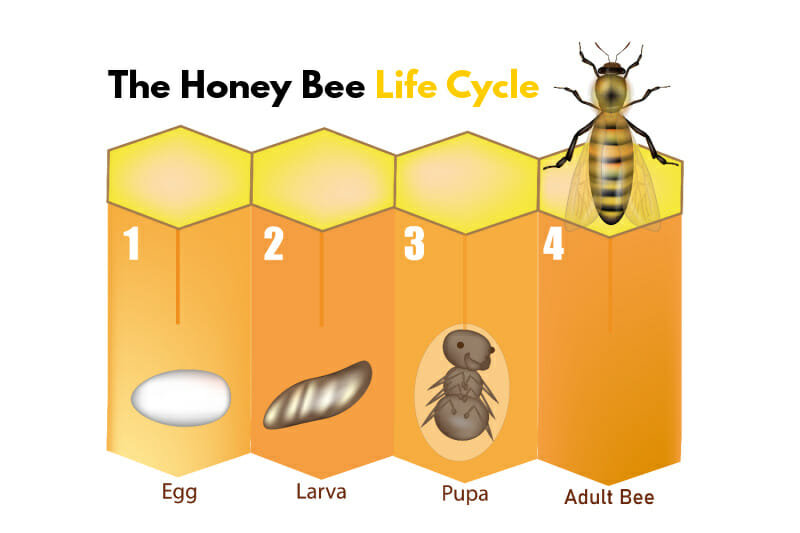
Imagine yourself as a tiny, buzzing bee, exploring the world and collecting nectar from vibrant flowers. Have you ever wondered what it takes for a bee to transform from a tiny egg to a fully-grown adult? In this captivating article, we will take you on a journey through the final stages of bee development, unraveling the secrets behind their incredible transformation. Prepare to be amazed as we unveil the remarkable process that turns a humble bee larva into a graceful, winged wonder of nature!

Egg to Larvae
The journey of a bee begins with humble beginnings – as an egg. The queen bee carefully lays her eggs within the honeycomb, where they will be lovingly tended to by the worker bees. These minuscule white eggs may be hard to spot, but they hold the promise of life and the future of the hive.
Larvae Stage
Once the eggs hatch, they give rise to tiny larvae. These larvae are completely dependent on the adult worker bees for their survival. They lack the physical characteristics we typically associate with bees, such as wings and a stinger. Instead, they resemble white, legless grubs. Despite their unassuming appearance, they play a crucial role in the development of a bee.
Feeding the Larvae
The nutrition of the larvae is of utmost importance during this stage. The worker bees work tirelessly to feed the growing larvae with a special substance called royal jelly. This nutrient-rich substance, secreted from glands in the heads of the worker bees, provides the larvae with the necessary proteins and vitamins they need to thrive. Thanks to this exceptional diet, the larvae experience rapid growth and undergo remarkable transformations.
Larvae Growth and Development
During the larvae stage, the bee larvae grow exponentially. They molt several times, shedding their outer layers to accommodate their increasing size. As they grow, the larvae develop distinct body segments, including a head, thorax, and abdomen. The rudimentary eyes become more prominent, and tiny bristles start to emerge on their bodies. Slowly but surely, the larvae begin to resemble the bees they are destined to become.

Pupa Stage
The pupa stage marks a critical milestone in the bee’s development. As the larvae reach their full size, they undergo a metamorphosis within a cocoon-like structure called a pupa. Inside this protective casing, the physical transformation occurs – from a humble larvae to an intricate and fully-formed adult bee.
Appearance of Pupa
Inside the pupa, the bee undergoes a significant transformation. Its body starts to take on the characteristics of an adult bee, including the development of wings, eyes, and other intricate body parts. The pupa itself differs in appearance from the larvae, with a more pronounced body shape and the distinct coloration of a developing bee. It is a fascinating sight to witness the pupa’s gradual transformation as it prepares for its grand debut.

Metamorphosis
Metamorphosis is a magical process that takes place within the pupa. Inside this chamber, cells divide, tissues are rearranged, and organs form. the bee’s entire body undergoes a complete restructuring, allowing it to transition from the juvenile form to its majestic final form. This awe-inspiring metamorphosis is truly a testament to the wonders of nature and reminds us of the beauty and intricacy of life.
Pupa Enclosure
Within the confines of the pupa, the bee is protected and sheltered during its final stages of development. The enclosure offers a safe space for the bee to undergo its physical changes without any disturbances. It is here that the pupa prepares for its ultimate transformation, building up strength and resilience for its imminent emergence as an adult bee.

Emerging as an Adult Bee
The momentous occasion arrives when the fully-developed bee emerges from its pupa enclosure as an adult bee. This process, known as eclosion, is a sight to behold. With great determination and effort, the bee breaks free from the confines of its former self. Through sheer perseverance and strength, it tears open the pupa casing and takes its first steps into the world as a magnificent adult bee.
The First Flight
After emerging from the pupa, the newly-formed bee must allow time for its wings to harden and for its body to fully adjust to its newfound abilities. Once the preparations are complete, the bee embarks on its first flight. This momentous occasion signifies the beginning of its crucial role within the hive – from gathering nectar and pollen to pollinating flowers, the adult bee now contributes its part towards the sustainability of the ecosystem.
As we observe the remarkable journey of a bee from egg to adult, we gain a deeper appreciation for the delicate intricacies of nature. This transformation, filled with growth, development, and awe-inspiring metamorphosis, is a testament to the marvels of life. So the next time you encounter a bee buzzing by, remember the incredible journey it has undergone to become the miraculous creature before your eyes.
